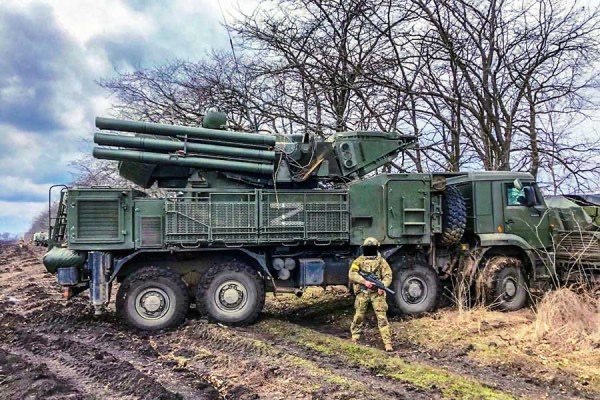

Russia: The cause of the struggle is tires made in China:
-Chinese military tire, Yellow Sea YS20-
Invasion of Ukraine:
In the photo from the artificial satellite,
There is a mixture of long-stretched Russian vehicles, combat units and transport units.
Frequent tire failures:
Various theories have been discussed as to the cause. It was
Military Tire Pro:
From the world’s military tire professionals
It was pointed out that “the tires used by the Russian army were cheap ones made in China.”
This Chinese product caused congestion in the Russian army and tank platoon.
The claims of the three experts are almost the same.
Published on SNS:
Surface-to-air missile vehicle
“Pantsir-S1”
“Cannon and missile are attached to KamAZ-6560, 8-wheel truck”.
You can see that “the rear wheels are completely stuck in the mud and the two front wheels are bent right next to each other.”
Military tires made in China
Chinese name: Yellow Sea YS20
The weight of the truck itself is 20t, and the total weight exceeds 30t.
It is equipped with Chinese-made military tires “Yellow Sea YS20 tires”.
This tire is “a tire that has a very bad reputation on the battlefield.”
Merkmal
https://merkmal-biz.jp/post/9140
Russie : La cause de la lutte, ce sont les pneus fabriqués en Chine :
-Pneu militaire chinois, Yellow Sea YS20-
Invasion de l’Ukraine :
Sur la photo du satellite artificiel,
Il y a un mélange de véhicules russes longs, d’unités de combat et d’unités de transport.
Défaillances fréquentes des pneus :
Diverses théories ont été discutées quant à la cause. C’était
Pneu militaire Pro :
Par les professionnels mondiaux du pneu militaire
Il a été souligné que “les pneus utilisés par l’armée russe étaient des pneus bon marché fabriqués en Chine”.
Ce produit chinois a provoqué une congestion dans l’armée et le peloton de chars russes.
Les affirmations des trois experts sont presque les mêmes.
Publié sur SNS :
Véhicule lance-missiles sol-air
“Pantsir-S1”“Le canon et le missile sont attachés au KamAZ-6560, camion à 8 roues”.
Vous pouvez voir que “les roues arrière sont complètement coincées dans la boue et les deux roues avant sont pliées l’une à côté de l’autre”.
Pneus militaires fabriqués en Chine
Nom chinois : Yellow Sea YS20Le poids du camion lui-même est de 20 t et le poids total dépasse 30 t.
Il est équipé de pneus militaires de fabrication chinoise “Pneus Yellow Sea YS20”.
Ce pneu est « un pneu qui a très mauvaise réputation sur le champ de bataille ».
Merkmal
Russland: Die Ursache des Kampfes sind in China hergestellte Reifen:
-Chinesischer Militärreifen, Yellow Sea YS20-
Invasion der Ukraine:
Auf dem Foto des künstlichen Satelliten
Es gibt eine Mischung aus langgestreckten russischen Fahrzeugen, Kampfeinheiten und Transporteinheiten.
Häufige Reifenpannen:
Über die Ursache werden verschiedene Theorien diskutiert. Es war
Militärreifen Pro:
Von den Militärreifenprofis der Welt
Es wurde darauf hingewiesen, dass „die von der russischen Armee verwendeten Reifen billige, in China hergestellte“ seien.
Dieses chinesische Produkt verursachte Staus in der russischen Armee und im Panzerzug.
Die Behauptungen der drei Experten sind fast gleich.
Auf SNS veröffentlicht:
Boden-Luft-Raketenfahrzeug
“Pantsir-S1”“Kanone und Rakete sind am KamAZ-6560, 8-Rad-LKW, angebracht”.
Man sehe, dass „die Hinterräder komplett im Schlamm stecken und die beiden Vorderräder direkt nebeneinander geknickt sind“.
Militärreifen hergestellt in China
Chinesischer Name: Gelbes Meer YS20Das Gewicht des LKWs selbst beträgt 20 t und das Gesamtgewicht übersteigt 30 t.
Es ist mit in China hergestellten Militärreifen “Yellow Sea YS20-Reifen” ausgestattet.
Dieser Reifen sei „ein Reifen, der auf dem Schlachtfeld einen sehr schlechten Ruf hat“.
Merkmal
Russia’s 40-mile-long military convoy near Kyiv has hardly moved in three days, says UK defence ministry | The Independent
https://www.independent.co.uk/news/world/europe/russia-military-convoy-kyiv-uk-b2028436.html[browser-shot url=”ターゲットURL” width=”400″]